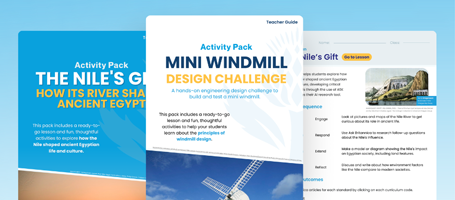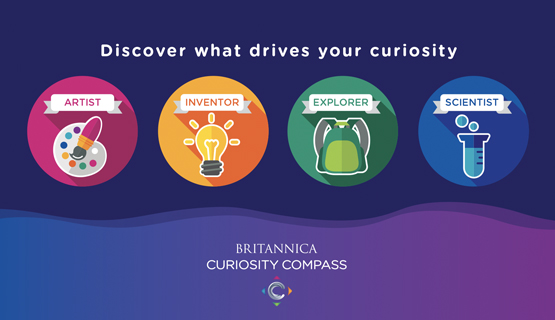Britannica launches Curiosity Day, in celebration of its 250th birthday, with a series of curiosity-sparking activities for classrooms, families, and lifelong learners.
What kind of curious are you? Take the Britannica Curiosity Compass Quiz to discover your curiosity profile and how each profile navigates discovery differently.
From the pages of Encyclopædia Britannica’s first edition in 1768 — published out of an unassuming Edinburgh print shop by an engraver, a printer, and a hired scholar who shared the crazy notion that knowledge should be accessible to anyone — to the millions of daily visits to Britannica’s current digital reference universe, we’ve been changing the way the world learns for a quarter of a millennium.
Literacy is more than the ability to read physical words on a page, to be literate is to have an innate enjoyment of learning new things. In the same vein, at the heart of every lifelong learner beats the same crucial trait, one that comes from a much deeper place than merely being “educated”: curiosity.
How do you enhance curiosity? Curiosity comes from people understanding the joy of learning. That’s what we need. And Britannica’s goal and our mission is to inspire curiosity and the joy of learning in new and engaging ways for the next 250 years.
We’re all born with our own inherent wonder at the world around us, but sometimes the business of education itself can get in the way of learning. Just like a muscle, curiosity needs to be stretched and strengthened, which is much easier said than done in the face of self-consciousness and standardised testing.
So in honour of Britannica’s 250th birthday, we’re inviting classrooms around the world to join us in celebrating curiosity and the joy of learning with the following curiosity workouts.
Curiosity Day Activities
The following activities work best when students sit in a circle where they can all see a smartboard and can have their own devices.
Primary/Elementary – Middle Activity
CHECK-IN: Feelings Check-In I
Students know what anger, sadness, and happiness feel like, but do they know what curiosity feels like? Spend a few minutes talking about a feeling that students are familiar with so that you can then explore a potentially new feeling: curiosity.
- Tell students: “Everyone, I feel nervous today. I’ve never tried this activity before. I didn’t eat a good breakfast today, I’m worried about my dog… I can tell I’m nervous because my chest is tight and my hands are a little shaky.”
- Ask students: “Have you ever been nervous? What do you feel like when you’re nervous? How do you know you’re nervous?”
- Discuss and share.
INTRODUCTION: Activity Introduction
Let students know that today you’re going to talk about curiosity, being curious, and what it feels like to be curious.
- Ask students: “When I’m curious, I feel excited. What does it feel like for you when you’re curious?”
- Discuss and share.
ACTIVITY: See-Think-Wonder: Kangaroo Boxing
This activity sparks curiosity with an intriguing visual image and invites students to dive deeper by uncovering details, understanding context and encouraging wonder.
Ask students:
- SEE: “What do you see ‘objectively’? Meaning, describe just the things you can see.”
- THINK: “What do you think is happening in this image, or what do you think about it?”
- WONDER: “What do you wonder about? What questions do you have about this picture?”
- Then scaffold with question starters: Who, What, When, Where, Why?
Extension:
- Research the background of the photo, either as a class or on one’s own.
- Ask students “How do you think we need to go about finding out what’s really happening here?”
- Discuss and share.
CHECK-IN: Feelings Check-In II
Check back in with your students. How are they feeling? Have they noticed new feelings about being curious?
- Tell students: “We just got curious!”
- Explain: Curiosity is a skill or a tool. Curiosity shows up in a lot of different places and a lot of different ways. There’s “school curiosity,” where your teachers give you some guidelines and help. Then there’s “real-world curiosity,” when it’s up to you to ask questions and find answers.
- Example: Your coach pulls the best player off the field in the middle of the game. You might feel like asking “What? Why did she do that?” Think to yourself, “What could her plan be? What does she see that I don’t see?”
- Ask students: “Any new feelings you notice about being curious? Excited, engaged? Are you uncomfortable geeking out about something?”
ACTIVITY: The Why Game
What’s the question behind the question? This activity takes students to new places and perspectives by encouraging them to ask why.
- Ask students: “Have you ever noticed that little kids are really good at asking ‘why’? How many times do you think we can ask ‘why’ about something?”
- Ask the class a question, such as “Why is it important to eat healthy?” or “Why do we have to go to school?”
- Pick one student to answer, then everyone asks “Why?”, and a second student provides an answer. Keep going until the class runs out of answers.
Extension:
- Break into small groups and keep playing, either with pre-written question starters or have students come up with their own on the spot.
CHECK IN: Feelings Check-In III
Ask students “How did it feel to ask questions? Were you nervous? Excited? Curious? How can you use this kind of thinking outside of class? At home? With your friends?”
More Educator Resources
Sign up with your email for more free resources from Britannica.
High School Activity: What’s your curiosity personality?
On their own devices, have students navigate to curiosity.britannica.com and take the Curiosity Compass Quiz. Upon completing the 10-question quiz, students will discover their curiosity profile as well as the artists, inventors, explorers and scientists throughout time who share their type of curiosity. Once everyone has their results, use the following questions to lead a discussion:
- How were you feeling about yourself before taking the quiz? Proud, self-conscious, shy, confident?
- How about after? Do you agree with your results?
- In your mind, which current or historical figures fall into the different curiosity categories? Why?
- When is it important to be persistently curious about something? When is it not? Why?
- How does it make you feel when your questions go unanswered? What do you do about it?
ACTIVITY: The Why Game
Have you ever noticed that little kids are really good at asking “why”? How many times can your students ask “why” about something?
- Ask the class a question, such as “Why is the truth important?”
- Pick one student to answer, then everyone asks “Why?”, and a second student provides an answer. Keep going until the class runs out of answers.
Extension:
- Break into small groups and keep playing, either with pre-written question starters or have students come up with their own on the spot.
Stay tuned for more curiosity-evoking activities, tools, and content from Britannica as we jump into our year-long celebration of 250 years of curiosity and joyful discovery. Share your Curiosity Compass profile results on social media, and see how your friends take on their curiosity.

